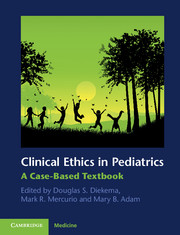Book contents
- Frontmatter
- Contents
- Contributors
- Preface
- Section 1 Core issues in clinical pediatric ethics
- Section 2 Ethical issues at the beginning of life: perinatology and neonatology
- Section 3 When a child dies: ethical issues at the end of life
- 18 End-of-life care: resolving disputes over life-sustaining interventions
- 19 Futility
- 20 Advance directives and DNR orders
- 21 The determination of death
- 22 Physician-assisted dying in children
- 23 The Groningen Protocol
- 24 Defining beneficence in the face of death: symptom management in dying children
- Section 4 Ethical issues posed by advances in medical technology and science
- Section 5 Children, public health, and justice
- Section 6 Special topics in pediatric ethics
- Index
- References
22 - Physician-assisted dying in children
from Section 3 - When a child dies: ethical issues at the end of life
Published online by Cambridge University Press: 07 October 2011
- Frontmatter
- Contents
- Contributors
- Preface
- Section 1 Core issues in clinical pediatric ethics
- Section 2 Ethical issues at the beginning of life: perinatology and neonatology
- Section 3 When a child dies: ethical issues at the end of life
- 18 End-of-life care: resolving disputes over life-sustaining interventions
- 19 Futility
- 20 Advance directives and DNR orders
- 21 The determination of death
- 22 Physician-assisted dying in children
- 23 The Groningen Protocol
- 24 Defining beneficence in the face of death: symptom management in dying children
- Section 4 Ethical issues posed by advances in medical technology and science
- Section 5 Children, public health, and justice
- Section 6 Special topics in pediatric ethics
- Index
- References
Summary
Case narrative
Zak was a happy, healthy 3-year-old boy. One morning, Zak’s parents had difficulty waking him. They noted some spots on Zak’s chest and face, and thought that he had a mild viral infection. As the day progressed, Zak became increasingly lethargic and the spots increased, so his mother brought him to the doctor. The pediatrician was very concerned and activated the emergency medical services. Zak was taken to a local emergency department where he was quickly diagnosed with meningococcal septic shock. Appropriate therapies were initiated and Zak was transported to the regional pediatric intensive care unit (PICU).
In the PICU, Zak continued to receive appropriate treatment. His parents remained at his bedside and were clearly loving and very concerned for their child’s welfare. After several days, it was apparent that the septic emboli (which are the hallmark of meningococcal sepsis) had blocked blood flow in many of Zak’s capillary beds. In addition to renal and hepatic impairment, Zak’s hands and feet had obvious signs of necrosis, and it was assumed that there were infarcted areas in his brain (although this could not be confirmed because he was not stable enough to move to the scanner).
- Type
- Chapter
- Information
- Clinical Ethics in PediatricsA Case-Based Textbook, pp. 123 - 130Publisher: Cambridge University PressPrint publication year: 2011



